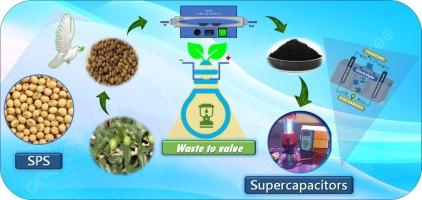从马钱子马铃薯种子中提取的分层多孔碳作为生物废弃物用于具有增强电压和能量密度的高性能超级电容器电极,并具有商业质量负载
IF 8.9
2区 工程技术
Q1 ENERGY & FUELS
引用次数: 0
摘要
超级电容器是为下一代便携式电子设备供电的重要部件,因为它们能够提供快速爆发的能量。然而,实现高能量密度和长寿命传统上依赖于不易获得或不环保的材料。本研究通过引入一种新的方法来制造高性能超级电容器电极,该方法来自可持续来源:马钱子马铃薯种子(SPS),一种现成的生物基产品。该研究详细介绍了这些种子转化成分层高表面积双模多孔碳的过程。这种独特的结构拥有1650 m2 - 1的显着表面积,这对于高效储能至关重要。利用这种创新材料,研究人员能够制造出具有引人注目的性能组合的超级电容器电极。这些电极具有3.0 V的宽工作电压,为储能装置提供了更大的工作窗口。此外,它们具有76 Fcm−3的高容量电容,表明能够在紧凑的空间内提供可观的功率。重要的是,即使在商业相关的质量负载下,电极也能保持出色的速率能力,确保其在实际应用中的功能。也许更令人印象深刻的是其卓越的耐用性,在4 Ag - 1,3.0 V下进行10,000次充放电循环后,其电容仍保持95%。这项研究为可持续和高性能超级电容器的发展铺平了道路,标志着以生态意识的方式为便携式和可穿戴电子设备供电迈出了重要的一步。本文章由计算机程序翻译,如有差异,请以英文原文为准。

Hierarchical porous carbon derived from Strychnos Potatorum Seeds as biowaste for high-performance supercapacitor electrodes with enhanced voltage and energy density with commercial mass loading
Supercapacitors are vital components for powering next-generation portable electronics due to their ability to deliver rapid bursts of energy. However, achieving high energy density and long lifespans has traditionally relied on materials that are either not readily available or not environmentally friendly. This study addresses this challenge by introducing a novel approach for creating high-performance supercapacitor electrodes from a sustainable source: Strychnos Potatorum Seeds (SPS), a readily available bio-based product. The study details the conversion of these seeds into hierarchical high surface area bi-model porous carbon. This unique structure boasts a remarkable surface area of 1650 m2g−1, which is crucial for efficient energy storage. Leveraging this innovative material, the researchers were able to create supercapacitor electrodes with a compelling combination of properties. These electrodes demonstrate a wide operating voltage of 3.0 V, signifying a larger operating window for energy storage device. Additionally, they exhibit a high volumetric capacitance of 76 Fcm−3, indicating the ability to deliver substantial power in a compact space. Importantly, the electrodes maintain excellent rate capability even at commercially relevant mass loadings, ensuring their functionality in real-world applications. Perhaps even more impressive is their exceptional durability, retaining 95 % of their capacitance after 10,000 charge-discharge cycles at 4 Ag−1, 3.0 V. This research paves the way for the development of sustainable and high-performance supercapacitor, marking a significant step forward for powering portable and wearable electronics in an eco-conscious manner.
求助全文
通过发布文献求助,成功后即可免费获取论文全文。
去求助
来源期刊

Journal of energy storage
Energy-Renewable Energy, Sustainability and the Environment
CiteScore
11.80
自引率
24.50%
发文量
2262
审稿时长
69 days
期刊介绍:
Journal of energy storage focusses on all aspects of energy storage, in particular systems integration, electric grid integration, modelling and analysis, novel energy storage technologies, sizing and management strategies, business models for operation of storage systems and energy storage developments worldwide.
 求助内容:
求助内容: 应助结果提醒方式:
应助结果提醒方式:


